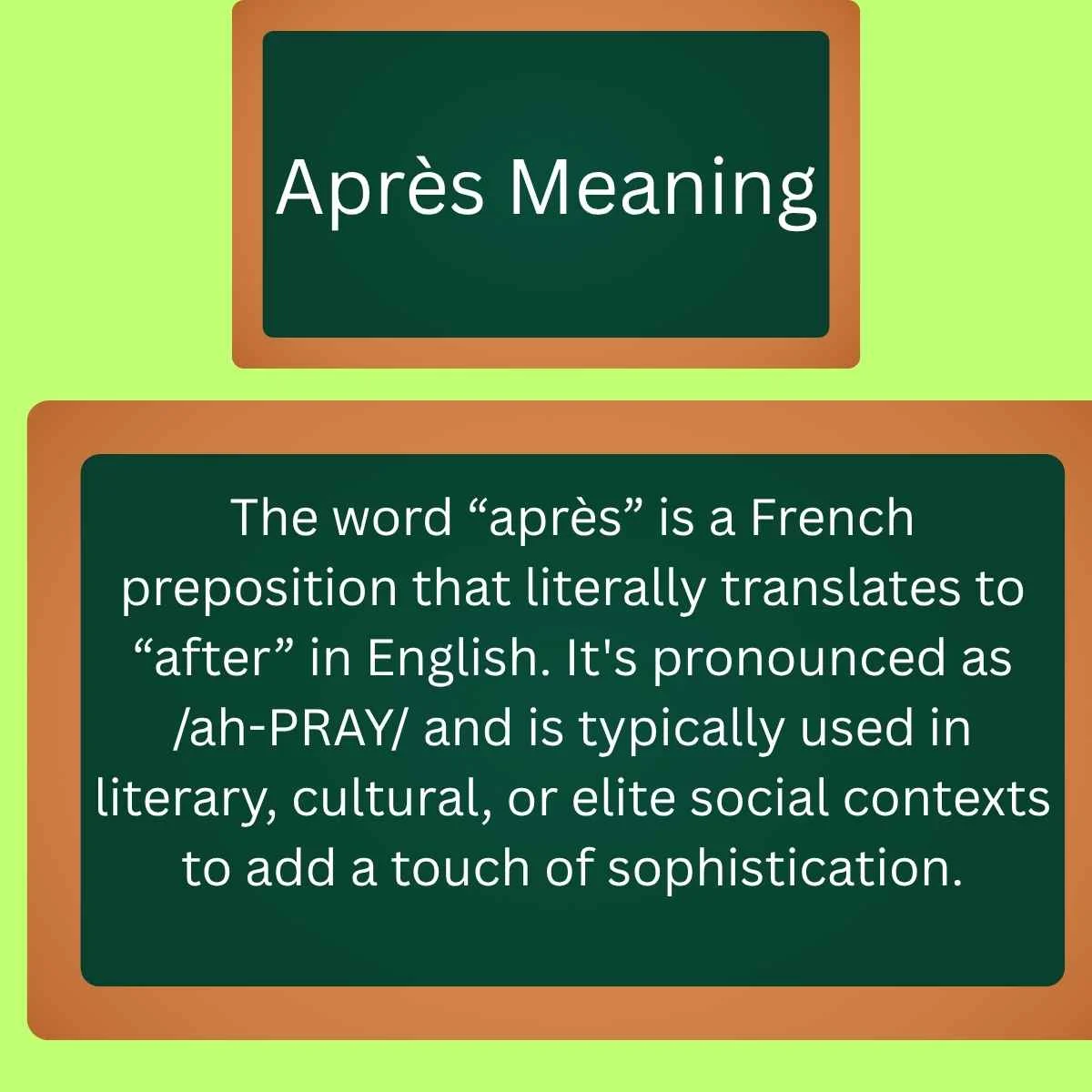Language is a living, evolving entity. Words borrowed from other tongues—like après—bring elegance and nuance to English, especially in writing and speech that leans into sophistication or international flair. But what exactly does après mean, and how should it be used in 2025’s communication landscape?
In this comprehensive guide, you’ll not only learn the definition and origin of après, but also how to use it effectively in different contexts. You’ll also discover professional, polite, and casual alternatives to the phrase, tailored for texting, business, social media, and daily conversations.
Let’s dive in. 🎯
🔤 What Does Après Mean?
The word “après” is a French preposition that literally translates to “after” in English. It’s pronounced as /ah-PRAY/ and is typically used in literary, cultural, or elite social contexts to add a touch of sophistication.
🧠 In Plain English:
“Après” = After.
But it’s more elegant, and it’s not used as commonly in informal settings.
🕰️ Origin and Historical Use
Après comes from Old French, rooted in Latin ad pressum, meaning “pressed to” or “following.” In English, its use increased during the 19th and 20th centuries, primarily among intellectuals, authors, and artists.
Examples from past literature:
- “Après moi, le déluge.” (After me, the flood) – Attributed to King Louis XV of France.
- “Après-ski” – A term that emerged in the 1950s, now widely recognized as referring to social activities after skiing.
📱 What Does Après Mean in Text or Social Media?
In texting or social media, “après” is rarely used unless someone wants to sound poetic, ironic, or culturally refined.
Example:
“We went wine-tasting après the vineyard tour. 🍷✨”
Here, it implies a chic or stylish vibe, different from simply saying “after.”
🔍 When to Use Après – and When to Avoid It
| Use It When… | Avoid It When… |
|---|---|
| Writing creative or poetic texts | Texting informally or casually |
| Branding or marketing for luxury | Talking in professional emails |
| Referring to fashion/culture | Writing for clarity and simplicity |
| Social media storytelling | Communicating with non-native speakers |
Pro Tip: In 2025, clear and concise language is favored in SEO writing, AI moderation, and mobile-first UX. Use après only when the tone calls for elegance or flair.
💬 10 Alternatives to Après With Real-Life Examples
Whether you’re drafting an email, updating a status, or texting a friend, here are ten alternatives to après that better suit various contexts. Each comes with examples and tone analysis.
1. After
Best for: All-around use (formal and informal)
Example:
“We went for dinner after the show.”
✅ Safe, clear, and direct. This is the default English equivalent and works in almost all contexts.
2. Following
Best for: Professional and academic writing
Example:
“Following the meeting, I’ll send out the summary notes.”
🧠 More formal than “after,” ideal for emails, reports, and structured content.
3. Post-
Best for: Technical or journalistic use
Example:
“Post-event feedback will be collected via survey.”
⚙️ Prefix style is great for headlines, business reports, and medical or tech writing.
4. Later
Best for: Casual and text messages
Example:
“We can grab coffee later if you’re free.”
📲 Perfect for social media or texting. Friendly, relaxed tone.
5. Subsequently
Best for: Formal or legal tone
Example:
“He was subsequently promoted to Senior Manager.”
📚 Use this in official documents, legal writing, or analytical reports.
6. Thereafter
Best for: Formal historical or process explanations
Example:
“The company rebranded in 2024. Thereafter, revenue doubled.”
⏳ A refined term used to describe something that continues after a specific event.
7. Then
Best for: Narration or chronological storytelling
Example:
“She graduated, then moved to New York.”
🧾 This keeps things chronological and simple. Great for storytelling.
8. In the wake of
Best for: News or emotional impact
Example:
“In the wake of the scandal, new regulations were introduced.”
🌊 Slightly dramatic; used when an action follows a significant event.
9. Next
Best for: Instructions and conversation flow
Example:
“Next, we’ll look at the marketing projections.”
📈 Clean, clear, and commonly used in presentations or sequences.
10. Down the line
Best for: Casual forecasts or speculative statements
Example:
“I might move abroad down the line.”
📆 Informal, often used to talk about the future or plans.
🎯 How to Choose the Right Alternative to Après
When selecting the best substitute, always consider:
- Tone: Is the conversation formal, casual, or creative?
- Audience: Who’s reading—peers, customers, friends?
- Medium: Email, text, social post, business doc?
Quick Tips:
- Use “after” or “following” in professional settings.
- Use “later” or “then” for everyday texting or chats.
- Use “post-” or “subsequently” for technical or report writing.
- Use “in the wake of” or “thereafter” when emotion or consequence matters.
📘 Examples of Après in Context (With Tone and Meaning)
1. “Après dinner, we walked under the stars.” 🌙
Tone: Romantic, poetic
2. “They hosted an après-gala cocktail party.” 🍸
Tone: Chic, luxurious
3. “The photoshoot included an après-scene interview.” 📷
Tone: Fashion/Entertainment industry lingo
In each case, après implies style, sophistication, or post-event flair.
🌍 Cultural Phrases Similar to Après
Other languages offer elegant prepositions or styles like après. Here are some modern global alternatives:
- “Nach dem” – German for “after the”
- “Dopo” – Italian for “after”
- “Después de” – Spanish for “after”
Using cultural equivalents may work in specific branding or aesthetic cases, especially in 2025’s globally connected content landscape.
✍️ Final Thoughts: Is Après Still Relevant in 2025?
Absolutely—but only in the right places. In 2025, language efficiency and tone adaptability are more important than ever. While après adds flair to your writing, most readers and platforms prefer words that are:
- Clear
- Direct
- Context-aware
So, unless you’re trying to sound poetic, artistic, or high-end, consider one of the superior alternatives listed above.
Keep your tone true to your message. The beauty of English is in its flexibility. Don’t just sound smart—communicate with impact.





